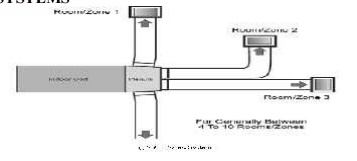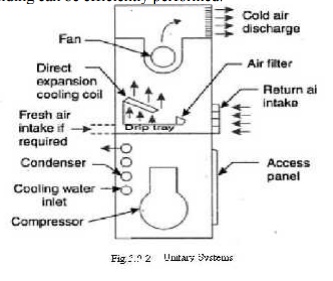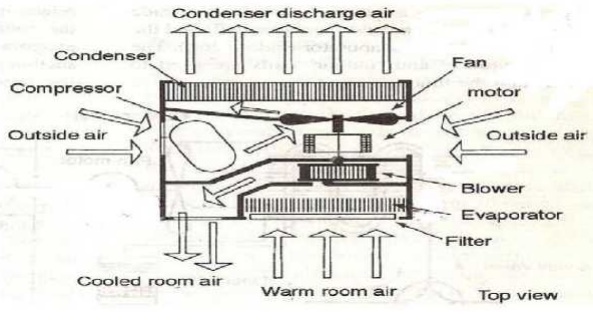Chapter: Mechanical and Electrical : Thermal Engineering : Refrigeration and Air Conditioning
Types of Air Conditioning
AIR CONDITIONERS
CONCEPT OF AIR CONDITIONING
Air conditioning (often referred to as aircon, AC or A/C) is the process of altering the properties of air (primarily temperatureand humidity) to more favourable conditions, typically with the aim of distributing the conditioned air to an occupied space to improve thermal comfort and indoor air quality.
TYPES OF AIR CONDITIONERS
• Room air conditioners
• Zoned Systems
• Unitary Systems
• Window Air-conditioning System
• Split Air-conditioning System
• Central air conditioning systems
1 ROOM AIR CONDITIONER
• Room air conditioners cool rooms rather than the entire home.
• Less expensive to operate than central units
• Their efficiency is generally lower than that of central air conditioners.
• Can be plugged into any 15- or 20-amp, 115-volt household circuit that is not shared with any other major appliances
2 ZONED SYSTEMS

3 CENTRAL AIR CONDITIONING
• Circulate cool air through a system of supply and return ducts. Supply ducts and registers (i.e., openings in the walls, floors, or ceilings covered by grills) carry cooled air from the air conditioner to the home.
• This cooled air becomes warmer as it circulates through the home; then it flows back to the central air conditioner through return ducts and registers

4.UNITARY SYSTEMS
A unitary air conditioning system comprises an outdoor unit including a compressor for compressing a refrigerant, an outdoor heat exchanger for heat exchange of the refrigerant and an expander connected to the outdoor heat exchanger, for expanding the refrigerant; a duct installed inside a zone of a building; a central blower unit having a heat exchanger connected to the outdoor unit through a first refrigerant pipe and a blower for supplying the air heat-exchanged by the heat exchanger to the duct; and an individual blower unit including a heat exchanger connected to the outdoor unit through a second refrigerant pipe and a fan for sending the air heat exchanged by the heat exchanger and disposed in a zone in the building, for individually cooling or heating the zone. Accordingly, cooling or heating operation is performed on each zone of the building, and simultaneously, additional individual heating or cooling operation can be performed on a specific space, so that a cost can be reduced and cooling or heating in the building can be efficiently performed.

5.WINDOW AIR-CONDITIONING SYSTEM
It is the most commonly used air conditioner for single rooms. In this air conditioner all the components, namely the compressor, condenser, expansion valve or coil, evaporator and cooling coil are enclosed in a single box. This unit is fitted in a slot made in the wall of the room, or often a window sill. Windows air conditioners are one of the most widely used types of air conditioners because they are the simplest form of the air conditioning systems. Window air conditioner comprises of the rigid base on which all the parts of the window air conditioner are assembled. The base is assembled inside the casing which is fitted into the wall or the window of the room in which the air conditioner is fitted. The whole assembly of the window air conditioner can be divided into two compartments: the room side, which is also the cooling side and the outdoor side from where the heat absorbed by the room air is liberated to the atmosphere. The room side and outdoor side are separated from each other by an insulated partition enclosed inside the window air conditioner assembly. In the front of the window air conditioner on the room side there is beautifully decorated front panel on which the supply and return air grills are fitted (the whole front panel itself is commonly called as front grill). The louvers fitted in the supply air grills are adjustable so as to supply the air in desired direction. There is also one opening in the grill that allows access to the Control panel or operating panel in front of the window air conditioner.

TYPES OF CENTRAL AC
• split-system
• An outdoor metal cabinet contains the condenser and compressor, and an indoor cabinet contains the evaporator
• Packaged
• The evaporator, condenser, and compressor are all located in one cabinet.
6 SPLIT AIR-CONDITIONING SYSTEM:
The split air conditioner comprises of two parts: the outdoor unit and the indoor unit. The outdoor unit, fitted outside the room, houses components like the compressor, condenser and expansion valve. The indoor unit comprises the evaporator or cooling coil and the cooling fan. For this unit you don't have to make any slot in the wall of the room. Further, the present day split units have aesthetic looks and add to the beauty of the room. The split air conditioner can be used to cool one or two rooms.

Energy Consumption
• Air conditioners are rated by the number of British Thermal Units (Btu) of heat they can remove per hour. Another common rating term for air conditioning size is the "ton," which is 12,000 Btu per hour.
• Room air conditioners range from 5,500 Btu per hour to 14,000 Btu per hour.
Energy Efficiency
• Today's best air conditioners use 30% to 50% less energy than 1970s
• Even if your air conditioner is only 10 years old, you may save 20% to 40% of your cooling energy costs by replacing it with a newer, more efficient model
Related Topics